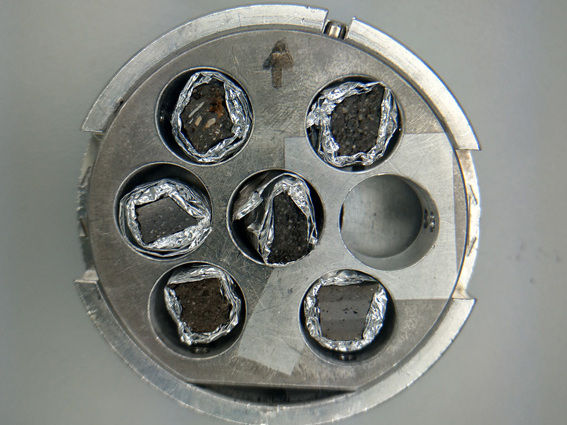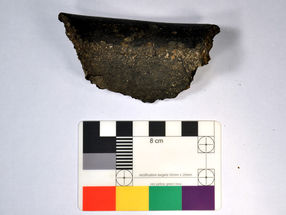What fat residues reveal about past eating habits
New method for determining the distribution of lipids in archaeological ceramics
Advertisement
Researchers at FAU, the University of Bristol and the University of Nottingham (UK) have developed a new method that enables fat residues in millennia-old vessels to be analysed more reliably than before. Using imaging mass spectrometry, the distribution and concentration of lipids - e.g. from meat, milk or cereals - can be determined without having to destroy the ceramics. The results were presented in the renowned journal PNAS.

Edge sherd of a vessel used for the examination
FAU/Simon Hammann

Samples in a sample holder for electron microscopy.
FAU/Simon Hammann


How did our ancestors live in the stone age? What did they eat, how did they cook and store their provisions? Information about a time from which there are no written records can be found in archaeological finds. In the 1960s, scientists discovered that lipids, i.e. fats, can survive for thousands of years in the walls of ceramics used for frying, cooking or as storage vessels. The analysis of fatty acids, for example, provided evidence that milk in northwest Anatolia was processed into cheese more than 9000 years ago. Residues of beeswax can also provide information on when humans began domesticating honey bees.
Lipids accumulate in pores
"In the majority of cases, we do not refer to such finds as lumps of tallow or wax, which stick together in grooves or corners to a thickness of centimetres," says Prof. Dr. Simon Hammann, junior professor of food safety and quality at FAU. "The fats have been absorbed by the porous matrix of the clay pots during repeated boiling and frying or through prolonged storage and have in some cases survived there for several millennia - protected from groundwater leaching and microbial degradation". After all, up to 100 micrograms, sometimes even several milligrams of lipid residues can still be detected in one gram of ceramic today. By means of gas chromatography and mass spectrometry, the biomolecular components are decoded - a chemical fingerprint is created which enables the identification of the food once used. The decisive disadvantage of this method: the ceramic samples must be completely pulverized, which on the one hand irretrievably destroys them and on the other hand does not allow any conclusions to be drawn about the distribution of lipids in the vessels.
Technology adapted from materials science
Simon Hammann received his PhD on the analysis of lipids in food and, as a postdoctoral fellow at the University of Bristol, studied grain-specific lipids in archaeological samples and the degradation of fats under different environmental conditions. "However, none of these experiments could answer the question of how lipids are actually incorporated into the inorganic ceramic structure and how they are distributed there," explains the food chemist. In order to solve this problem, he decided to use a technology that is mainly used in biomedicine and materials science: secondary ion mass spectrometry (SIMS). In this imaging method, a high-energy ion beam releases elements from the surface without destroying the sample. A mass spectrometer integrated into the device determines the chemical composition of the desorbed substances. "Together with colleagues from the University of Nottingham, which has one of the most modern SIMS devices, I was able to obtain excellent data from my archaeological samples," says Hammann. "Instead of a few isolated signals in tiny pores, we found lipid zones of up to 400 micrometers in some samples."
Lipid distribution provides information on the preparation method
With SIMS technology, which can deliver a brilliant spatial resolution of well below one micrometer, Hammann was the first to succeed in imaging lipids in coherent structures. This is a very decisive advance, because a complex picture of how the fats are distributed in the ceramic could in future allow conclusions to be drawn about the way food is prepared: "If we find particularly high lipid contents in the upper part of a clay pot, we know that cooking was predominantly done in it," explains Simon Hammann. "Maximum lipid accumulations near the bottom rather indicate roasting." Until now, several shards of a vessel were needed to determine its intended use. With imaging mass spectrometry, a single piece of glass could be sufficient.
Salts as lipid conservators
During his investigations, Simon Hammann discovered another important aspect of lipid conservation in archaeological ceramics: Many of the larger inclusions, some of which were visible to the naked eye, were associated with calcium salts. "Calcium carbonate, for example in the form of shells or limestone, was often used during the firing of the vessels and later reacted with the fatty acids to form fatty acid calcium salts," explains Hammann. "These salts are extremely poorly soluble in water and therefore a very good conservator of lipids". The classical extraction method using chloroform and methanol cannot dissolve these salts; only the use of acidic extraction agents makes the lipids bound in this way accessible. Hammann: "We are still at the beginning of research work here, but lipids bound as calcium salts are a valuable source for the further analysis of archaeological finds".
Note: This article has been translated using a computer system without human intervention. LUMITOS offers these automatic translations to present a wider range of current news. Since this article has been translated with automatic translation, it is possible that it contains errors in vocabulary, syntax or grammar. The original article in German can be found here.
























































